In spite of its small size, this island was much harder to navigate than the others we had visited. As the map below shows, it is very mountainous, and the narrow roads snake up, down, and around those mountains in circuitous ways that didn't always make sense. I was glad that we had hired a private driver who knew where to go and how to get there.
Cool fact about St. Lucia: It is the ONLY country in the whole world named after a woman. St. Lucia (also known as St. Lucy) was a Christian woman who lived in Syracuse, Sicily, and was killed during the rule of the Roman Emperor Diocletian in 304 AD.
Another interesting fact about St. Lucia, and indeed about most of the Caribbean islands, is that the native people, called "Caribs," were replaced not by their conquerors, but by their conquerors' slaves. Other than Puerto Rico, every island we visited was populated predominantly by those of African descent.
We docked at Castries, the capital city, and met up with our driver, a native St. Lucian who has never ONCE left this little island. He was very nice, but he didn't offer any information unless we asked, and then his answers were only a few words spoken very quietly. It was a little frustrating.
The island is 40 miles long, and thus bigger than some of the other Caribbean Islands we had visited. However, distances seemed MUCH greater because of the convoluted roads. Our first stop was an overlook where the French used to have a military base. A guide waiting for us on the site (in whom I didn't have a lot of confidence) pointed out three tiny prison cells that he said were used to house 80-90 prisoners each:
He demonstrated what it was like for a prisoner, but I didn't think it was a fun as he did:
His knowledge of the local flora was excellent, however, and he was good about pointing out the different things growing around the area, including this spectacular African tulip tree, a non-native invasive species that can quickly take over an area:
Bob was intrigued by the site guide's unusual knitted white hat and asked him if he always wore it. He said he does, especially in public. It is filled with his dreadlocks:
He pointed out some mature okra, just waiting for someone (not me) to harvest it and enjoy it (definitely not me):

Here are some guava, which I had never seen anywhere but a grocery store, and not even there very often, although I do love guava juice:

The guide told us that this was a calabash tree, and a light came on in my head. In 4th grade, a girlfriend and I had spent weeks perusing the dictionary for alliterative insults and had come up with "miscreant miser," "ignominious ilk," and "calabash can of caffeine." Until our trip to St. Lucia, I had no idea what a calabash actually was.
. . . and a hat:
The horizon hardly appearsto exists in the Caribbean--the sea and sky seem to fade into one another:
Bob had read about snake handlers on St. Lucia, and so he asked our driver if there was a place where we could see some. Within a few minutes, we stopped at a roadside place where a man had a snake that we could hold--for a fee. Never one to pass up a reptilian opportunity, Bob allowed the man to place the snake, some kind of a python, in his hands.
Of course, that wasn't enough for the snake handler. He wanted a double tip, I'm sure, which meant I needed to hold it as well. After almost four decades of marriage to the Snake Whisperer, it was not very intimidating:
Our next stop took us a little closer to the Gros Piton and its brother Petit Piton, but later on we would get even better views:
. . . on a guided walk through exotic horticulture:
The needle sharp spines protruding from this bark made me wonder if the tree is a cross between a pine and a cactus:
Hey, what is that weird flower that kind of looks like a pine cone? It's a baby pineapple, of course! For some reason I thought pineapples grew on trees (like money):
Here are its older brothers and sisters:
I love this plant with its fire-tipped leaves. How do you think it would survive the winter on mainland USA? It wouldn't make it in Montana or Utah, but maybe in California (if I put a heater next to it on cold nights)?
There was a not-so-exotic scraggly organic garden:
Not far away is Petit Piton (say that ten times as fast as you can), or "small peak." It is 2,438 feet tall--just 92 feet shorter than its big brother. Together, the Pitons were named a World Heritage Site in 2004.
Aww, I LOVE this view!
Yes, we were really there. It's good we have photos; otherwise, I would think it was a dream:
I don't know--could this be REAL? Maybe it was a dream after all.
When we arrived at the trail, the skies were blue, but clouds move in quickly in the Caribbean, and we did get a little wet before we got to the end of the trail. Of course we had no umbrella with us because it was sunny when we started out:
But the rain passed over quickly and soon the skies were blue again. Our next stop was the sulphur springs of Soufriere Volcano, which is considered to be dormant even though it last erupted in the late 1700s. It sure was letting off a lot of smelly steam:
This is the Caribbean version of Yellowstone:
There are even mudpots:
I've never seen a cashew tree before, and I'm glad they put signs on everything for us dumb North Americans:
Up the stairs for a better view:
There were several places where people were bathing. I wonder if the sulphur smell gets into your pores? I wonder how hot it is? I didn't want to find out the answer to either question if it meant I had to get in the water:
All this outdoor stuff had made us really hungry, but I'll cover lunch in the next post.





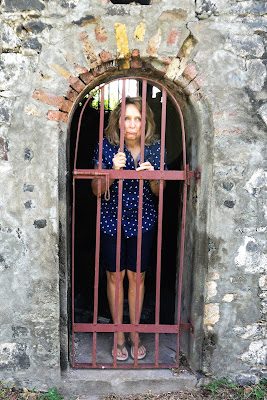


















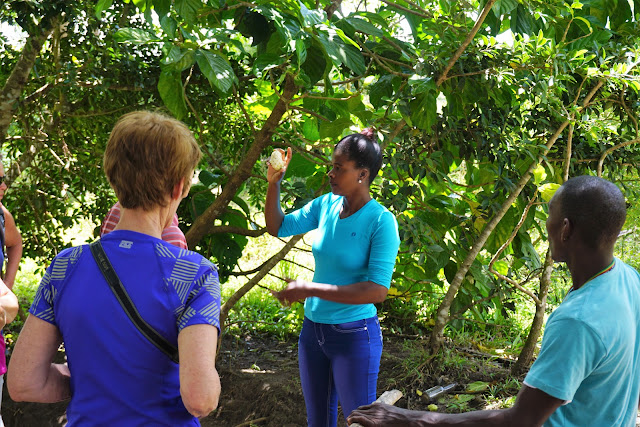
















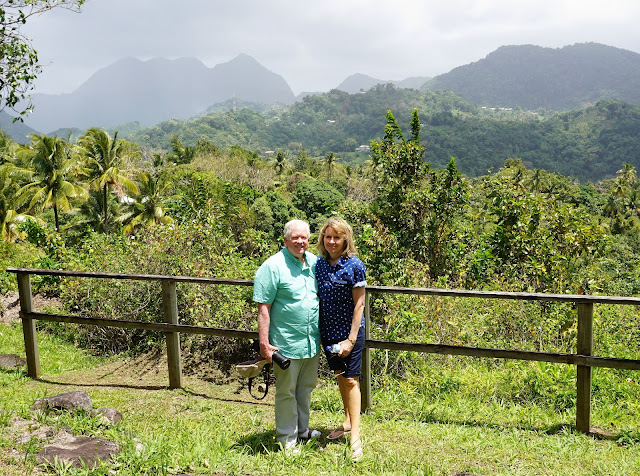




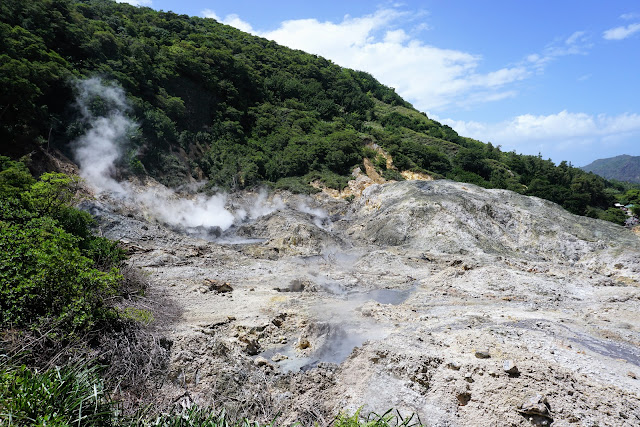
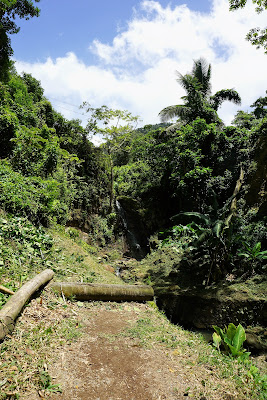








This was such a beautiful island with so much variety. Next time we need to find a tour guide/driver instead of a driver.
ReplyDelete